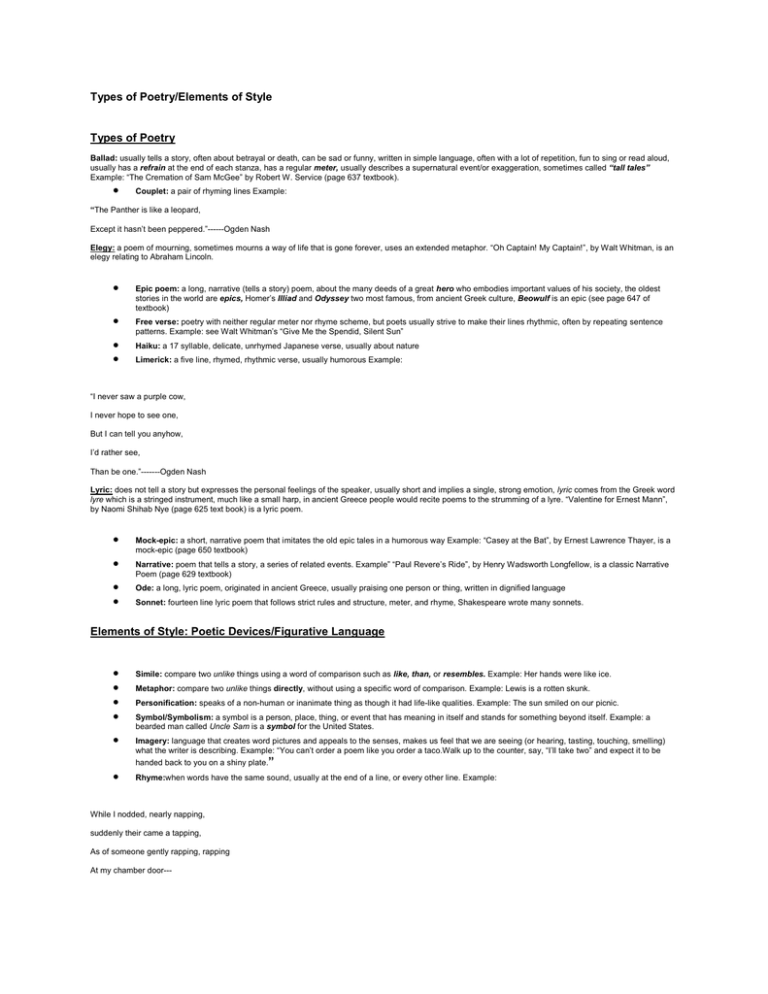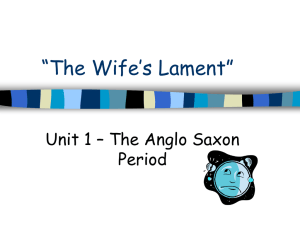Types of Poetry
advertisement

Types of Poetry/Elements of Style Types of Poetry Ballad: usually tells a story, often about betrayal or death, can be sad or funny, written in simple language, often with a lot of repetition, fun to sing or read aloud, usually has a refrain at the end of each stanza, has a regular meter, usually describes a supernatural event/or exaggeration, sometimes called “tall tales” Example: “The Cremation of Sam McGee” by Robert W. Service (page 637 textbook). Couplet: a pair of rhyming lines Example: “The Panther is like a leopard, Except it hasn’t been peppered.”------Ogden Nash Elegy: a poem of mourning, sometimes mourns a way of life that is gone forever, uses an extended metaphor. “Oh Captain! My Captain!”, by Walt Whitman, is an elegy relating to Abraham Lincoln. Epic poem: a long, narrative (tells a story) poem, about the many deeds of a great hero who embodies important values of his society, the oldest stories in the world are epics, Homer’s Illiad and Odyssey two most famous, from ancient Greek culture, Beowulf is an epic (see page 647 of textbook) Free verse: poetry with neither regular meter nor rhyme scheme, but poets usually strive to make their lines rhythmic, often by repeating sentence patterns. Example: see Walt Whitman’s “Give Me the Spendid, Silent Sun” Haiku: a 17 syllable, delicate, unrhymed Japanese verse, usually about nature Limerick: a five line, rhymed, rhythmic verse, usually humorous Example: “I never saw a purple cow, I never hope to see one, But I can tell you anyhow, I’d rather see, Than be one.”-------Ogden Nash Lyric: does not tell a story but expresses the personal feelings of the speaker, usually short and implies a single, strong emotion, lyric comes from the Greek word lyre which is a stringed instrument, much like a small harp, in ancient Greece people would recite poems to the strumming of a lyre. “Valentine for Ernest Mann”, by Naomi Shihab Nye (page 625 text book) is a lyric poem. Mock-epic: a short, narrative poem that imitates the old epic tales in a humorous way Example: “Casey at the Bat”, by Ernest Lawrence Thayer, is a mock-epic (page 650 textbook) Narrative: poem that tells a story, a series of related events. Example” “Paul Revere’s Ride”, by Henry Wadsworth Longfellow, is a classic Narrative Poem (page 629 textbook) Ode: a long, lyric poem, originated in ancient Greece, usually praising one person or thing, written in dignified language Sonnet: fourteen line lyric poem that follows strict rules and structure, meter, and rhyme, Shakespeare wrote many sonnets. Elements of Style: Poetic Devices/Figurative Language Simile: compare two unlike things using a word of comparison such as like, than, or resembles. Example: Her hands were like ice. Metaphor: compare two unlike things directly, without using a specific word of comparison. Example: Lewis is a rotten skunk. Personification: speaks of a non-human or inanimate thing as though it had life-like qualities. Example: The sun smiled on our picnic. Symbol/Symbolism: a symbol is a person, place, thing, or event that has meaning in itself and stands for something beyond itself. Example: a bearded man called Uncle Sam is a symbol for the United States. Imagery: language that creates word pictures and appeals to the senses, makes us feel that we are seeing (or hearing, tasting, touching, smelling) what the writer is describing. Example: “You can’t order a poem like you order a taco.Walk up to the counter, say, “I’ll take two” and expect it to be handed back to you on a shiny plate.” Rhyme:when words have the same sound, usually at the end of a line, or every other line. Example: While I nodded, nearly napping, suddenly their came a tapping, As of someone gently rapping, rapping At my chamber door--- Edgar Allen Poe, from “The Raven” Rhythm: the repetition of stressed and unstressed syllables, this provides the poem’s beat. Example: A gentleman dining at Crewe Found quite a large mouse in his stew Said the waiter “Don’t shout, And wave it about, Or the rest will be wanting one too.” Meter: a fixed pattern of accented and unaccented syllables in lines of fixed length to create rhythm Alliteration: repetition of initial sounds, i.e. “…picked a peck of pickled peppers…” Onomatopoeia: the use of a word whose sound suggests its meaing, i.e. buzz






